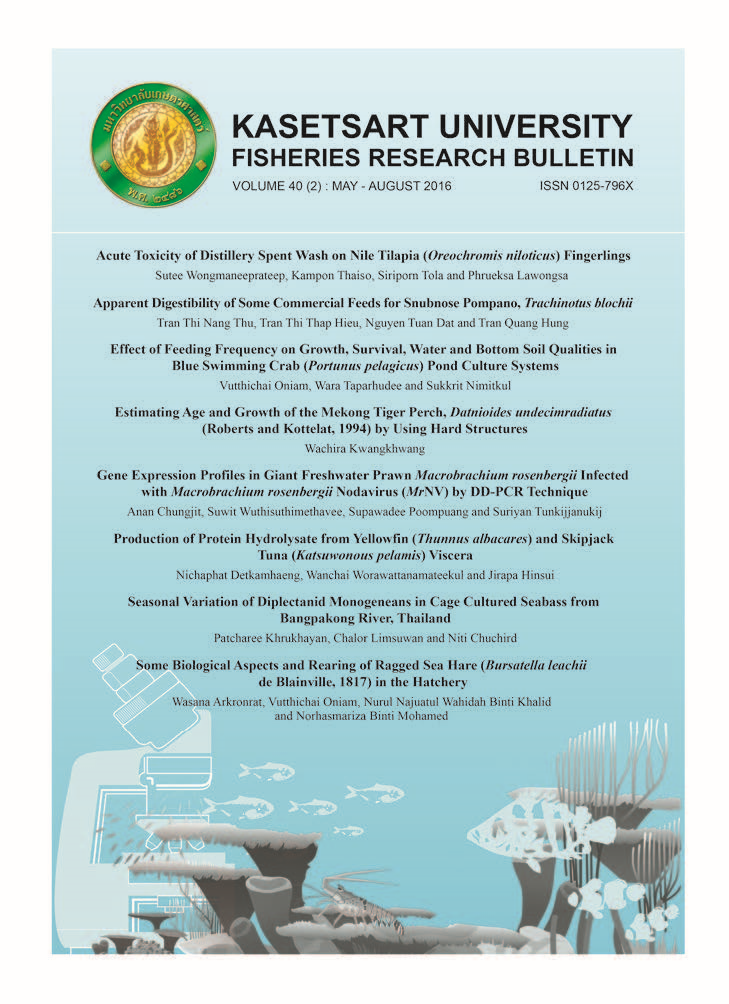Acute Toxicity of Distillery Spent Wash on Nile Tilapia (Oreochromis niloticus) Fingerlings
Main Article Content
Abstract
Acute toxicity tests using distillery spent wash, treated by anaerobic digestion process, on Nile tilapia (Oreochromis niloticus) fingerlings were conducted under laboratory conditions for 96 h using static bioassay method. In the defmitive test, seven groups with three replications of experimental fish (body weight 5.6±0.45 g/fish) were exposed to seven concentrations of distillery spent wash (0, 12, 14, 16, 18, 20 and 22 ml/L). No mortality was observed during the 96 h in groups of control fish (0 ml/L) and fish exposed to 12ml/L. The 100% mortality rate was achieved only in fish group exposed to 22 m1/L of distillery spent wash. The median lethal concentration (LC50) of distillery spent wash to fish for 24, 48, 72 and 96 h were 18.547, 18.024, 17.965 and 17.965 ml/L, respectively. In addition, health of fish exposed to over 12ml/L (14, 16, 18, 20 and 22 ml/L of distillery spent wash) were affected. The behavioral changes of fish in these groups displayed rapid opercular movement and frequent gulping of air at the surface of the water. This abnormal behavior of fish increased after 24 h. Fish swimming activity decreased and later fish settled to the bottom of the aquaria, and their opercula moved slower until they eventually stopped when mortality occurred. Gill coloration was pale and the gills were clogged with sediment from distillery spent wash. Tilapia mortality was directly related to undesirable properties of distillery spent wash. Therefore, distillery spent wash should be suitably treated before disposal to the ecosystem or utilization in aquaculture.
Article Details
References
2. Botelho, RG., V.L. Tornisielo, R.A. de Olinda, L.A. Maranho and L. Machado-Neto. 2012. Acute toxicity of sugarcane vinasse to aquatic organisms before and after pH adjustment. Toxicol. Environ. Chem. 94: 2035-2045.
3. Das, M., H. Chakraborty, R. Singandhupe, S. Muduli and A. Kumar. 2010. Utilization of distillery wastewater for improving production in under productive paddy grown area in India. J. Sci. Ind. Res. 69: 560-563.
4. El-Sayed, A.F.M. 2006. Tilapia Culture. CABI Publishing, CABI International: Willingford, Oxfordshire, UK.
5. Faculty of Science. 1987. Agro-industrial wastes impacts on the phong water quality; a research report submitted to USAID, Faculty of Science, Khon Kaen University: Khon Kaen, Thailand.
6. Faculty of Science. 1991. The phong rehabilitation and water quality improvement planning; a study report submitted to Khon Kaen Provincial Committee, Khon Kaen University: Khon Kaen, Thailand.
7. Finney, D. 1971. Probit Analysis Cambridge University Press. Cambridge, UK.
8. Inmuong, Y. 1998. Thailand water pollution crisis: a case on massive fish deaths in Nam Phong river. Fact Sheet Environmental Health.
9. Khangarot, B.S., P.S. Rao, S.S. Shekhawat and V.S. Durve. 1985. Acute toxicity of distillery effluent on a freshwater fish and three pond snails. Acta Hydroch. Hydrob. 13: 53-58.
10. Kumar, S. and K. Gopal. 2001. Impact of distillery effluent on physiological consequences in the freshwater teleost Channa punctatus. Bull. Environ. Contam. Toxicol. 66: 617-622.
11. Kumar, S., S. Sahay and M. Sinha. 1995. Bioassay of distillery effluent on common guppy, Lebistes reticulatus (Peter). Bull. Environ. Contam. Toxicol.54: 309-316.
12. Kumar, V., L. Wati, F. Fitz Gibbon, P. Nigam, I. Banat, D. Singh and R. Marchant. 1997. Bioremediation and decolorization of anaerobically digested distillery spent wash. Biotechnol. Lett. 19: 311-314.
13. Mahesh, M. 2015. Influence of distillery effluent on survivability growth limb bud emergence and metamorphosis of tadpoles of Fejervarya limnocharis (Anura: Ranidae). Int. J. Life Sci. 4: 66-69.
14. Mohana, S., B.K. Acharya and D. Madamwar. 2009. Distillery spent wash: treatment technologies and potential applications. J. Hazard. Mater. 163: 12-25.
15. Noga, E.J. 2010. Fish Disease: Diagnosis and Treatment. 2nd ed. John Wiley & Sons, New Jersey.
16. Orlrue, E.R., A.U. Osaigbovo and D.E. Vwioko. 2005. Growth of maize (Zeamays L.) and changes in some chemical properties of an ultisol amended with brewery effluent. Afr. J. Biotechnol. 4: 973-978.
17. Pant, D. and A. Adholeya. 2007. Biological approaches for treatment of distillery wastewater: a review. Bioresour. Technol. 98: 2321-2334.
18. Patil, V. and V. Ghole. 2010. Comparative toxicological studies of distillery effluent treatments such as UASB reactor followed by an oxidizer unit using Cyprinus carpio fish. Environ. Technol. 31: 185-191.
19. Phanapavudhikul, S. 1999. Direct use of spent distillery wash liquor on paddy fields in Thailand. Water Environ. J. 13:420-422.
20. Ramana, S, A. Biswas and A. Singh. 2002a. Effect of distillery effluents on some physiological aspects in maize. Bioresour. Technol. 84: 295-297.
21. Ramana, S., A. Biswas, S. Kundu, J. Saha and R. Yadava. 2002b. Effect of distillery effluent on seed germination in some vegetable crops. Bioresour. Technol 82: 273-275.
22. Ramakrishnan, M. 1991.Effect of distillery (sugar-mill) effluent on physiology of freshwater fish. Ph. D. Thesis submitted to Madurai Kamaraj University, Madurai, India.
23. Ramakritinan, C.M., A.K. Kumaraguru and M.P. Balasubramanian. 2005. Impact of distillery effluent on carbohydrate metabolism of freshwater fish, Cyprinus carpio. Ecotoxicol. 14: 693-707.
24. Reish, D.L. and P.S. Oshida. 1987. Manual of methods in aquatic environment research, Part 10: short-term static bioassays. Food & Agriculture Org.
25. Saroja, D., V. Meenakshi and V. Indra. 2013. Effects of raw alcohol distillery effluent on the behavioural and biochemical aspects of a fresh water fish, Cyprinus carpio (Linn.). Int. J.Nov.Tren. Pharma. Sci. 3:33-38.
26. Satyanarayan, S. 2011. Toxicity evaluation of through fish bioassay raw bulk drug industry wastewater after electrochemical treatment. Iranian J. Environ. Health Sci.Eng. 8: 373-380.
27. Saxena, K.K. and R.R.S. Chauhan. 2003. Oxygen consumption in fish, Labeo rohita (HAM.) caused by distillery effluent. Ecol Environ. Conserv.9: 357-360.
28. Shukla, A. and J.P. Shukla. 2012a. Distillery effluent induced alterations in the haematological profile of fingerling of Colisa fasciatus. J. Environ. Biol 34: 923-925.
29. Shukla, A. and J.P. Shukla. 2012b. Distillery effluent induced alterations in the nucleic acid and protein during testicular cycle of Colisafasciatus, (Bl. & Schn), a tropical freshwater perch. Int. J. Pharm. Biol Sci. 3(1): 532-537.

